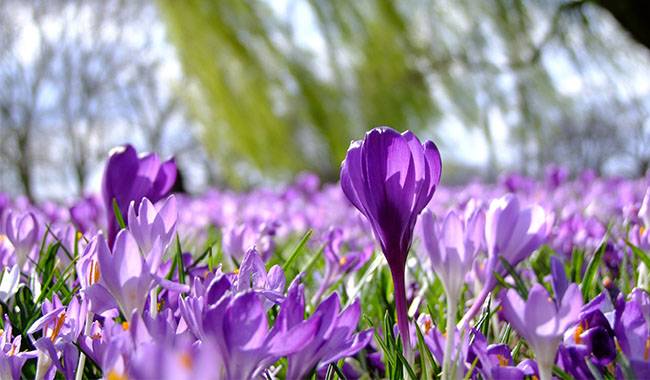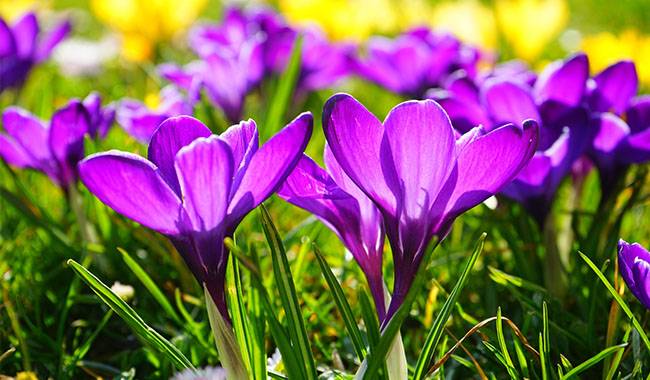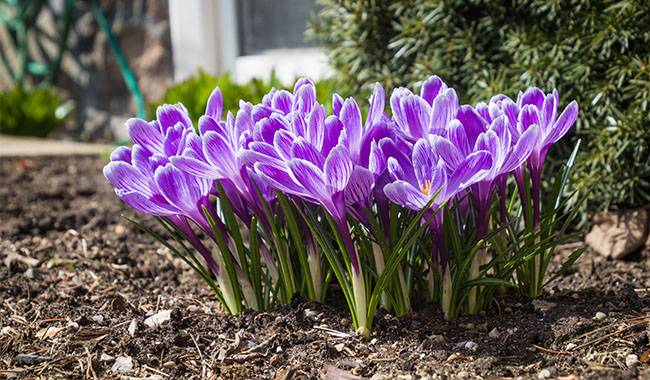
The king of exquisite spring, the Crocus flower is one of the most desirable early flowers. The patches of Crocus flowers in gardens and parks look stunning. But not only can you enjoy their beauty on a walk, but not necessarily in spring. They are also perfect for indoor cultivation and are considered the best plant species to know about indoor bulbs. With careful temperature control and proper watering, the miniature stars’ colorful blooms will transform windowsills for weeks and weeks to come.
THE TOUCHING FLOWERING PERIOD OF THE INDOOR CROCUS FLOWER

There is no plant in the Iris family more valuable than the Hidden Crocus flower. These earthworm-like perennials are known not only for their stigmas, the most prized spice on earth but also for their unique beauty and even more beautiful indoors.
All-natural flowering (both spring and fall) varieties of the large-flowered hybrid Crocus flower, including spring Crocus vernus, Crocus chrysanthus, and seed Crocus sativus, are most often selected for indoor cultivation. The delicate watercolor color variations of white-flowered flowers, yellow, and lilac-pink can be chosen to suit your taste.
Crocus flowers do not exceed 5 inches (12 cm) in height at their peak. The bulbs are round and up to 1 inch (2.5 cm) in diameter. Crocus flower’s stems are short and narrow. Root leaves, covered from below by thin scales, develop at the same time as the flowering or after flowering. Dark, linear, and hardy, they look even more magnificent in pots than in the garden.
The single cup-shaped Crocus flower, with its large perianth and corolla divided into six oval lobes, needs no introduction. Up to 3-4 inches (7.5-10 cm) in diameter, they look enormous against the background of foliage. The stamens with erect anthers and the filiform stigma with three stigmas emphasize the special delicacy of the flowers. So do the translucent texture of the petals and their shiny veins.
In nature, Crocus flowers bloom in spring and autumn, but in-room forms, they can be made to bloom before New Year’s Eve or spring holidays if dormant conditions are recreated. Early maturing varieties are more suitable for the early winter blooming period; for the spring blooming period, it is best to look for medium and late-maturing types.
THE PLANTING METHOD IS THE KEY TO SUCCESS
For indoor cultivation, use the largest, mature corals of at least 1 inch (2.5 cm) in diameter – elite, select planting material. The easiest way is to obtain unique Crocus flowers specially prepared for faster flowering, but regular garden Crocus flowers are also suitable. Before planting, store-purchased corms in a cool, dark place at a temperature of about 60-62 °F (16-17 °C).
If digging your garden plants, pick the strongest corals in mid-June. Dry for 2 weeks at a warm temperature of 70-80 °F (21-32°C), sort, disinfect with a fungicide solution, and then place the bulbs in a box or paper bag in a cool, airy place. For early plantings, store at 48-62 °F (9-17 °C), eventually decreasing, and for late plantings, store at about 62 °F (17 °C).
Only healthy, undamaged, quality corals are suitable for baking. Inspect them carefully before planting and repot them in a weak fungicide (manganese or systemic preparation) solution. Plant bulbs of the same size in the same pot.
PLANTING, CONTAINERS, AND SUBSTRATES
For February flowering, plant Crocus flowers in pots in early October. For winter flowering, shift planting to mid-September; for March flowering, postpone until November.
Crocus flowers are not planted one by one. Even indoors, they can be planted in groups of at least five plants. Depending on the size of the pot or box, these groups can be either large or compact. There are only two requirements for containers – drainage holes and not too deep (the standard is the height of 3-4 palms).
For planting in pots, you should choose a mixture of soil with nutrients and lightweight. The easiest way to do this is to buy a special bulb substrate. You can also make your potting soil at home.
- Mix equal amounts of coarse sand and good quality compost with a small amount of perlite.
- Mix equal amounts of sod, leaf soil, peat, and sand (half of the sand can be replaced with perlite).
- Add sand or perlite (1:1) to the general-purpose substrate.
Pour drainage agent at the bottom of the container and substrate on top at the height of 2-3 inches (5-7.5 cm). At this stage, it is easy to water the soil.
There are a few rules for planting.
Place the bulb vertically, with the bottom of the bulb facing down, and cover it with the substrate so that the soil layer above the top is 1 inch (2.5 cm). Surface planting often results in bent shoots and is best done with sufficient experience.
When placing clusters of Crocus flowers, place them as close to the bulbs as possible, but do not allow them to touch each other-about 0.2-0.4 inch (0.5-1 cm) apart, much less the pot walls-1 inch (2.5 cm) apart.
Crocus flowers can be potted in inert soil such as perlite, vermiculite, expanded clay, moss, or hydrogel, leaving the top above the substrate.
CROCUS FLOWER CONDITIONS AND CARE
The container containing the planted bulbs should remain rooted for about two to three months. This period will last 50-70 days; for winter flowering, it will last 100-115 days. The unique Crocus flower during flowering often takes 2-3 weeks to root. The preparation period can be extended by lowering the temperature in the second half of the rooting period to “acclimatize” to the required date.
During the rooting stage, Crocus flowers need a combination of “shade + cool.”
- Temperature of about 41-48 °F (5-9°C) – (When planting in September, it is recommended to lower the temperature to 41 °F (5°C) from the second month onwards.
- Complete protection from light (it is convenient to put a light shield on the container).
- Ventilation.
- Light soil moisture and low watering.
Once the first signs of growth appear, you should begin to pay close attention to the condition of the plants and the moisture content of the soil. However, there is no need to rush to change the conditions until the seedlings grow to 1-2 inches (2.5-5 cm).
CONDITIONS AND CARE DURING THE FLOWERING STOP AND FLOWERING PERIOD

Plants with fully grown flowering arrows can be gradually moved to light and warm locations. For 3 to 5 days, it is best to place them in a semi-shady area or a cool place with a hood and raise the temperature only slightly – to 50-59 °F (10-15°C), if there is no suitable location – by ventilating or laying snow in trays to cool the plants).
In the future, it will be necessary to provide Crocus flowers.
- as bright a light as possible, on a sunny windowsill (best in the south)
- as cool as possible – preferably no more than 64 °F (18°C) during the day and 48-53 °F (9-12°C) at night.
The colder the room where Crocus flowers bloom, the longer they can be enjoyed. They flower for up to 20-25 days at an average temperature of about 60 °F (16 °C) and 10 days in a warm room above 70 °F (21 °C). Crocus flowers open their magnificent flowers only in sunny weather. No underwater activity is allowed.
Slowly and carefully resume normal watering as the plant begins to grow and gradually stop watering as the leaves begin to turn yellow. Dry out the top layer of soil and water Crocus flowers gently, but do not let them get too dry. To compensate for the warm room temperature, sprinkle snow on them or water Crocus flowers with cold water.
Spraying in hot conditions and with a radiator will help alleviate the “wrong” conditions.
Feeding Crocus flowers is not necessary. However, if needed, Crocus flower can be given a compound fertilizer, special bulb fertilizer, or tomato fertilizer at the beginning of the growing season, or every two weeks until flowering.
It does not hurt to apply potassium and phosphorus fertilizer after flowering.
CROCUS FLOWER AFTER FLOWERING
Once-blooming is over. There are only two ways to save the bulbs and preserve the plant or throw it away. Crocus flowers are not the most expensive bulbs, but full-grown perennials should not be tossed.
They only bloom once in the room. But if you let the leaves fade, let the bulbs rest until August, and then plant them in a warm, protected clearing in your garden, you can guarantee yourself the pleasure of seeing spreading clusters and colorful early blooms for several years. If you don’t have a garden, you can always bury the bulbs in the yard.
PESTS, DISEASES, AND PROBLEMS IN CROCUS FLOWER CULTIVATION
Most of the losses of the Crocus flower are due to careless watering. Standing water in the trays and constant dampness in the soil can quickly destroy even the strongest of plants. The only remedy is to be careful and control the drying of the substrate.
The most troublesome pest problem for domestic Crocus flower grass is the aphid, which prefers small bulbs. At the first sign of a pest, isolate Crocus flower and begin an insecticide treatment. Nematodes and other soil pests, including onion mites, are also dangerous.
Any serious infestation and signs of bud deformation require that the plants be destroyed.







